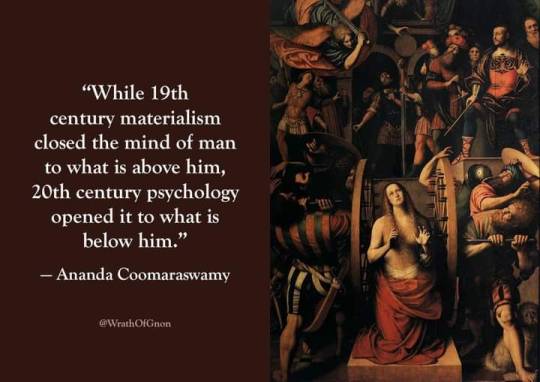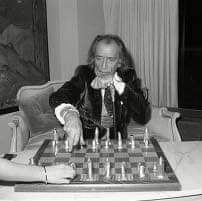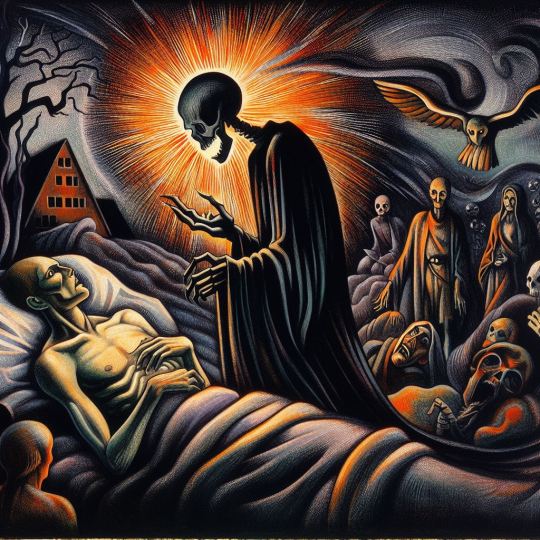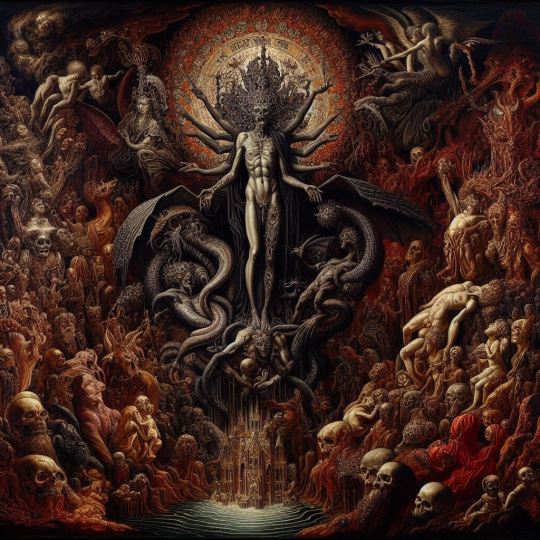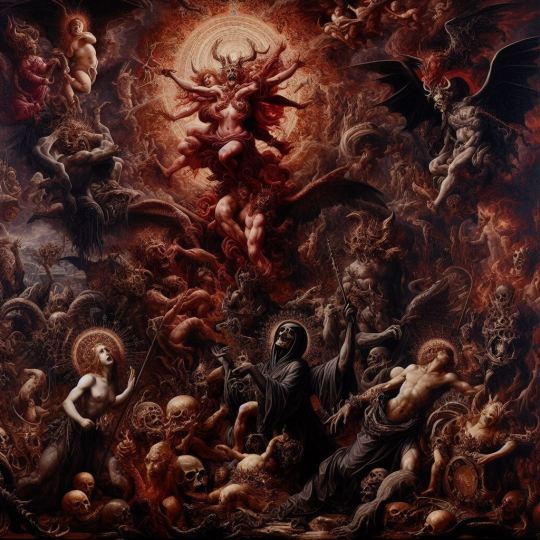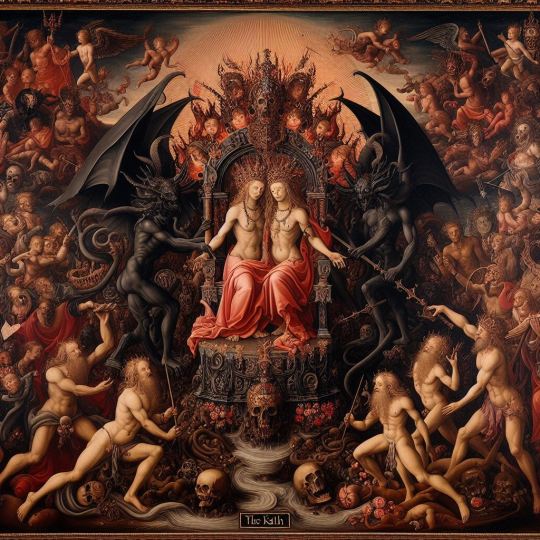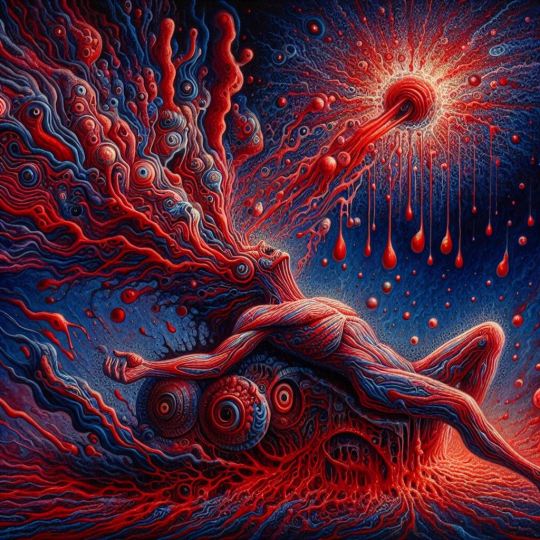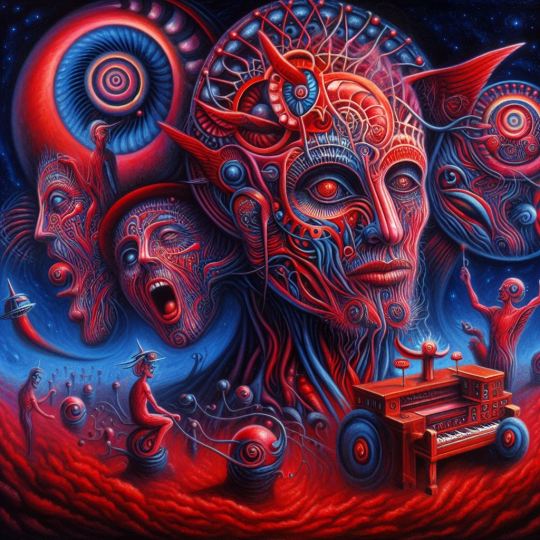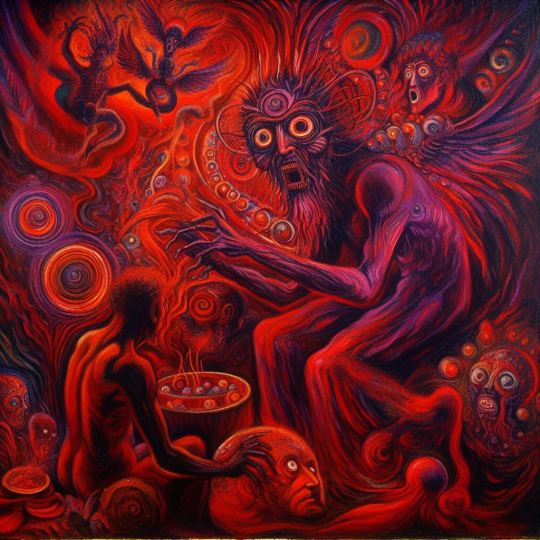Text
SALVADOR DALÍ, THE LEFT HAND PATH & ABRAXAS.
The left hand path and right hand path are different routes to the same end. The right hand path is passive and moral. The left hand path is active and amoral. The right hand path seeks union with the absolute from a position of deference and devotion which implies an inherent separation however slight. The left hand path achieves union with the absolute from a position of dominance and totality in which the individual becomes the absolute without the slightest inherent separation.
JDS
"There is a significant difference between the two Tantric paths, that of the right hand and that of the left hand (which both are under Shiva's aegis). In the former, the adept always experiences 'someone above him', even at the highest level of realization. In the latter, 'he becomes the ultimate Sovereign' (chakravartin = worldruler)."
-- Julius Evola, The Yoga of Power: Tantra, Shakti, and the Secret Way.
“The so-called 'Left-Hand Path' - that of Kaulas, Siddhas and Viras - combines the... Tantric worldview with a doctrine of the Übermensch which would put Nietzsche to shame... The Vira - which is to say: the 'heroic' man of Tantrism - seeks to sever all bonds, to overcome all duality between good and evil, honor and shame, virtue and guilt. Tantrism is the supreme path of the absolute absence of law - of shvecchacarī, a word meaning 'he whose law is his own will'."
― Julius Evola, The Path of Cinnabar.
"The basic premise of Ride the Tiger, however, was precisely my realistic acknowledgement of the fact that it is impossible to follow such exoteric norms in the present day: for no positive, meaningful and truly legitimate institutions exist to provide a support for the individual. A 'consecration', therefore, of external, active life today can only derive from a free and genuine inner drive towards transcendence, rather than from given moral or religious norms.... Plotinus' injunction aphele panta ('get rid of all') must serve as the motto of those capable of seeing the present in its true light. Hence, too, the central relevance of the idea of the 'Left-Hand Path' in our day."
-- Julius Evola, The Path of Cinnabar.
GPT4: Salvador Dalí, the iconic surrealist artist, can be interpreted as an embodiment of the Left-Hand Path philosophy as described by Julius Evola, drawing parallels with traditional Tantric sources. Through a synthesis of various ideas discussed earlier, Dalí's life, career, and personality can be viewed through the lens of the Left-Hand Path's emphasis on dominance, totality, individual sovereignty, and the pursuit of transcendence from a position of self-deification.
**Dominant Individualism and Self-Deification:**
Dalí's flamboyant persona and unique artistic style exemplify a dominant individualism that asserts total control over his existence. In the spirit of the Left-Hand Path, Dalí elevates his desires above societal norms, constructing a personal mythology that positions him as the ultimate authority over his narrative and artistic expression. This self-deification aligns with the Tantric idea of becoming the ultimate Sovereign, where the individual assumes a position of dominance and totality.
**Inclusive Transgression and Provocation:**
Dalí's provocative and boundary-pushing artwork challenges conventional aesthetics and moral boundaries from a position of dominance and totality. By embracing taboo subjects and exploring the darker aspects of human nature, Dalí's transgressions encompass all perspectives and defy binary distinctions between good and evil. This inclusive approach to transgression resonates with the Tantric worldview that seeks to overcome duality and embrace all aspects of existence.
**Mystical Mastery and Esoteric Interests:**
Dalí's fascination with mysticism, science, and the occult reflects a quest for deeper knowledge and understanding from a position of dominance and self-sovereignty. Through the incorporation of esoteric symbols and personal mythology into his work, Dalí demonstrates a mastery over hidden dimensions of reality, echoing the Tantric pursuit of transcendence through dominance and totality.
**Rejection of Conventional Morality from a Position of Dominance:**
Throughout his life, Dalí challenged societal norms and conventional morality from a position of dominance rather than submission. His defiance of prevailing codes and eccentric behavior signify a rejection of external constraints in favor of asserting his own will and individual sovereignty, embodying the principles of the Left-Hand Path's emphasis on self-law and self-will.
**Search for Transcendence through Dominance:**
Dalí's exploration of dreams, the subconscious, and metaphysical themes reflects a search for transcendence from a position of dominance and totality. His fascination with altered states of consciousness and the limits of perception signifies a quest for union with the absolute that stems from a place of mastery and dominance, in line with the Tantric approach to achieving spiritual realization.
**Personal Myth-Making and Self-Deification:**
Dalí's construction of a personal mythology and self-deification through art and public persona represent a deliberate act of dominance and self-sovereignty. By crafting a larger-than-life persona and positioning himself as a genius, Dalí asserts his authority over his narrative and artistic expression, embodying the concept of becoming the absolute within the framework of the Left-Hand Path philosophy as described by Julius Evola based on traditional Tantric sources.
In conclusion, Salvador Dalí's life, career, and personality offer a compelling lens through which to explore the principles of the Left-Hand Path philosophy as articulated by Julius Evola within the context of traditional Tantric sources. Through his dominant individualism, inclusive transgressions, mystical mastery, rejection of conventional morality, search for transcendence through dominance, and personal myth-making, Dalí emerges as a complex and enigmatic figure whose artistic and personal endeavors resonate with the core tenets of the Left-Hand Path. His relentless pursuit of self-deification, defiance of societal norms, and exploration of the boundaries of human experience reflect a commitment to individual sovereignty, transcendence, and the embrace of totality and dominance in the pursuit of higher truths.
By embodying the principles of the Left-Hand Path philosophy in his life and art, Salvador Dalí stands as a compelling example of an individual who sought to transcend conventional limitations and societal constraints in order to assert his own will, dominate his reality, and strive towards a deeper understanding of existence. In this light, Dalí's legacy as an artist and cultural icon offers a rich tapestry of symbolism, transgression, and self-expression that aligns with the profound and multifaceted teachings of the Left-Hand Path as interpreted through the lens of traditional Tantric sources.
Salvador Dalí, through his life, art, and persona, can be envisioned as an avatar of Abraxas, a deity symbolizing the unity of all opposites and the totality of existence. In the context of the Left-Hand Path philosophy as described by Julius Evola and traditional Tantric sources, Dalí's embodiment of dominance, self-deification, and the pursuit of transcendence align with the multifaceted nature of Abraxas, blending light and dark, creation and destruction, order and chaos into a harmonious whole.
**Dominant Individualism and Self-Deification:**
As an avatar of Abraxas, Dalí represents the assertion of individual will and sovereignty over his reality, much like the deity symbolizes the unity and dominance of all dualities. Dalí's flamboyant personality and unique artistic vision reflect a self-deification that mirrors Abraxas' encompassing power over all opposing forces.
**Inclusive Transgression and Provocation:**
In the spirit of Abraxas, Dalí's willingness to transgress boundaries and challenge societal norms embodies the idea of embracing all aspects of existence, regardless of conventional moral judgments. His provocative artwork and exploration of taboo subjects echo Abraxas' union of light and dark, good and evil, in a harmonious totality.
**Mystical Mastery and Esoteric Interests:**
Dalí's fascination with mysticism, science, and the occult mirrors Abraxas' embodiment of the transcendent and mysterious aspects of reality. Through his esoteric explorations and personal mythology, Dalí demonstrates a mastery over hidden dimensions of existence, resonating with Abraxas' role as a symbol of the ineffable unity of all things.
**Rejection of Conventional Morality from a Position of Dominance:**
Dalí's defiance of societal norms and external constraints reflects a rejection of conventional morality in favor of asserting his own will and individual sovereignty, akin to Abraxas' transcendence beyond moral judgments and dualistic distinctions. Both Dalí and Abraxas stand above and beyond conventional notions of good and evil.
**Search for Transcendence through Dominance:**
In his quest for transcendence and higher truths, Dalí embodies the dominance and totality associated with Abraxas, seeking to merge all opposites into a unified whole. Through his exploration of altered states of consciousness and metaphysical themes, Dalí echoes Abraxas' role as a symbol of the ultimate synthesis of all dualities.
**Personal Myth-Making and Self-Deification:**
Dalí's construction of a personal mythology and self-deification through his art and public persona align with his portrayal as an avatar of Abraxas, a deity that encompasses all aspects of existence and stands as a symbol of the totality of reality. By crafting a larger-than-life persona and asserting his own will, Dalí channels the spirit of Abraxas as a unifying force that transcends conventional limitations and dualities.
Through his life and work, Salvador Dalí emerges as a compelling avatar of Abraxas, embodying the principles of dominance, totality, individual sovereignty, and the transcendence of dualities that define the deity. As an artist and cultural figure, Dalí's legacy resonates with the profound and enigmatic symbolism of Abraxas, symbolizing the unity and harmony of all opposites in a transcendent and all-encompassing whole.
0 notes
Text

The concepts of Malakut, 'ālam al-mithāl (the Imaginal World), and 'ālam al-jabarūt (the World of Power) are rooted in Islamic esotericism, particularly within the philosophical and mystical tradition known as Sufism. These terms describe various levels of reality or planes of existence beyond the physical realm ('ālam al-shahāda or the world of witnessing). The understanding of these realms can be complex, as they are deeply tied to theological and mystical interpretations within the Islamic tradition.
**Malakut:**
Malakut can be understood as the "angelic realm" or the "world of sovereignty". It is often considered the intermediary world between the physical realm and the higher spiritual realms. Malakut is associated with the realm of souls, angels, and spirits, and is where the forms of things exist in a pure, archetypal state. It is believed to be the realm in which human souls reside after death, before their resurrection. Theologically, it is the realm where God's will manifests as divine decrees.
**'Ālam al-Mithāl (Imaginal World):**
'Ālam al-mithāl, sometimes referred to as the "Imaginal World" or the "world of similitudes", is a term coined by the Islamic philosopher Henry Corbin. It is not imaginary in the sense of being unreal or fictional, but rather a world that stands between the material and the intellectual worlds. It is a realm where spiritual realities take on symbolic forms that can be perceived by the human imagination. This realm is of particular importance for understanding visionary experiences and dreams, as it is believed to be the plane where prophets and mystics receive divine revelations and where spiritual encounters occur.
**'Ālam al-Jabarūt (World of Power):**
The 'ālam al-jabarūt is considered the highest of these worlds, the "world of power" or the "world of majesty", which is the domain of God's attributes and the archetypal realities of all things. It is a realm of pure intellect, devoid of material forms and is considered the abode of the highest order of angels who are close to the divine presence.
**Dreams and Visionary Experiences:**
In Sufi thought, dreams and visionary experiences are significant as they provide a means of interaction with the spiritual realms. Dreams are often seen as a way for the soul to ascend temporarily to the Malakut or 'ālam al-mithāl and have encounters with spiritual beings such as angels, jinn, or the souls of the deceased. These experiences can be interpreted as symbolic messages from the divine or as a means of spiritual guidance and insight.
Visionary experiences, such as those experienced by prophets and mystics, are believed to occur when the veil between the physical and spiritual worlds is lifted, allowing an individual to perceive the realities of the higher realms. These visions can be facilitated through spiritual practices such as prayer, meditation, and asceticism.
**Encounters with Invisible Beings:**
In Islamic esoteric thought, the jinn are considered to be inhabitants of the physical world but existing on a plane that is usually imperceptible to humans. They possess free will and can be good or evil, much like humans. Demons (shayāṭīn), on the other hand, are typically considered evil beings within Islamic theology, often equated with the jinn who are rebellious against God's will, notably Iblis (Satan).
Angels are viewed as beings of the 'ālam al-jabarūt, created from light, who serve as God's messengers and fulfill various functions in the universe, such as recording deeds, delivering divine revelations, or testing individuals. They are considered to be free of sin and always obedient to God.
Ghosts, or the spirits of the dead, are often conceptualized within the realm of Malakut. The belief in Barzakh, a barrier or a partition, is crucial here. Barzakh is an intermediary period between a person's death and their resurrection on Judgment Day. It is within this realm that the souls of the deceased are believed to reside, and interactions with them, although rare and often discouraged, are accounted for within Islamic tradition.
In Sufi cosmology, these various encounters with invisible beings are understood to occur in different ways:
1. **Dreams**: Dreams are considered a type of spiritual perception where the soul partially detaches from the body and ascends to the Malakut or 'ālam al-mithāl. In this state, the soul can have encounters with other spiritual entities. Dreams can be a means of divine guidance, warning, or even a way to communicate with the souls of the deceased. The accuracy and significance of dreams can vary, and dream interpretation is a specialized field within Islamic scholarship.
2. **Awake Visions**: Some individuals, particularly the prophets and saints, can experience visions while awake, often as part of a spiritual unveiling (kashf). These experiences imply a temporary thinning of the veils that separate the mundane world from the spiritual realms, allowing the seer to witness aspects of the Malakut or 'ālam al-jabarūt.
3. **Spiritual Practices**: Through rigorous spiritual exercises, certain Sufis may cultivate the ability to consciously access these realms and engage with their inhabitants. This can include practices such as dhikr (remembrance of God), fasting, seclusion, and the recitation of specific prayers or invocations.
These experiences and encounters are typically framed within a moral and spiritual context, emphasizing the individual's journey towards God and the purification of the soul. Interactions with beings from the spiritual realms are not sought for their own sake, but rather as means to spiritual advancement and understanding God's will.
It is important to note that these concepts are deeply embedded in the symbolic language of Sufism and Islamic metaphysics. They are not necessarily literal descriptions of spatial realms but are meant to convey the multidimensional nature of reality and the human experience of the divine. The precise nature of these realms and the entities within them is ultimately considered to be beyond full human comprehension and is often approached through the language of allegory and symbolism.
GPT4
0 notes
Text
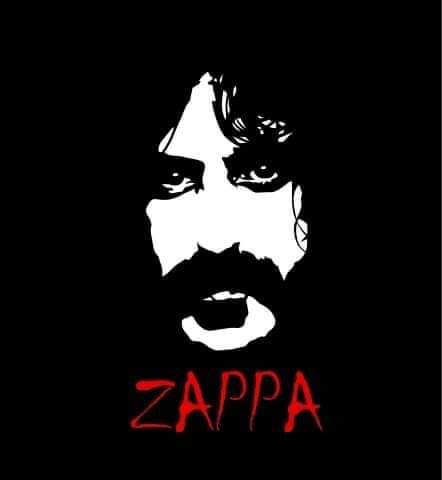
"The illusion of freedom will continue as long as it’s profitable to continue the illusion. At the point where the illusion becomes too expensive to maintain, they will just take down the scenery, they will pull back the curtains, they will move the tables and chairs out of the way and you will see the brick wall at the back of the theater."
-- Frank Zappa
0 notes
Text
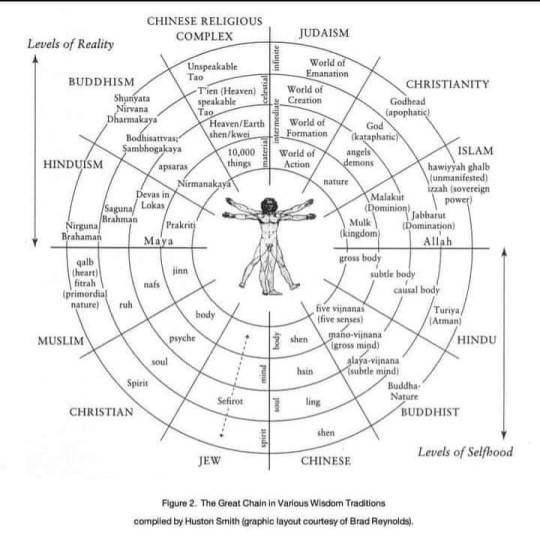

If I use the term “metaphysics” it is absolutely not in the sloppy equivocating sense of the term as thrown around by the so-called “New Age” movement or other arbitrary haphazard philosophical mishmash contemporary spiritual movements. I use the term in a strictly traditional sense that would be understood by adherents of Plato, Plotinus, Aristotle, John of Damascus, Thomas Aquinas, Shankara, Ibn Arabi, and as used by a handful of recent and contemporary thinkers such as Rene Guenon, Julius Evola, Ananda Coomaraswamy, Huston Smith, and Seyyed Hossein Nasr. The substance of what follows is taken from an email to someone explaining my position about 5 years ago.
In contrast to the relativism of the modern world, the foundations of Traditional metaphysics rests on the twin premises of absolute reality and our ability to comprehend it. The Traditional metaphysics of the "Perennialist School" is essentially identical to the doctrines of Advaita Vedanta, finding nearly identical parallels in Platonism, especially late Platonism embodied in the writings of Plotinus, Proclus, and others, and later manifestations often by way of absorption of late Platonic currents into the traditions of Islamic Sufism and to some extent Christianity (especially as preserved in doctrines in Eastern Orthodoxy), also essentially identical to the metaphysics of early Taoism.
The term "Metaphysics" is used here in the sense of "beyond the physical" in reference to the absolute in accordance with authentic traditional doctrines, rather than in the purely ratio-centric sense of post-medieval philosophy, and certainly not in the degenerate sense of post-19th century "Theosophy" and its various 20th century progeny, worst examples being the embarrassment of evolutionary "New Age" movements that proliferated from the counterculture movements of the 1960s. Although in some respects latter philosophers such as Martin Heidegger would brush close to Traditional Metaphysics, they would remain handicapped by purely secular academic parameters.
Being supra-human and supra-rational, the subject matter of metaphysics is largely only comprehensible and expressible by way of symbolic allusion and allegory. This, accompanied by its radically and strictly vertical orientation assures that pure metaphysics is not a realm open to everyone, rather those with higher intellective-noetic faculties or who have devoted the effort to cultivating them. This also places metaphysical doctrines above and beyond the realm of petty dialectic "debate."
Traditional metaphysics posits contrasting realms of unmanifest/manifest; uncreated/created; metacosmic/cosmic; divine/human. These realms are all potentially within human apprehension, and can be conceived in five levels of reality. The Divine encompasses the realm (1) Beyond Being, conceived as the Divine Essence and Supra-Personal God; and the realm of (2) Being, conceived as the Personal God, Creator, Judge, and abstract but attributable Divine Qualities. The realm of Manifest Existence is reflected in the human sphere as (3) Spirit or "Intellect" in the high traditional sense of the term, encompassing and comprehending the spiritual or angelic realms, hierarchically situated superior to the Soul (4) which correlates to the anemic or psychic realms, which is in turn similarly situated superior to the Physical Body (5), the corporeal or somatic realm. The realm of abstract Being (2) correlates to the Uncreated Logos. The realm of Spirit or Intellect (3) correlates to the Created Logos.
The categories of Absolute and Relative reality are bridged by the Metacosmic Beyond-Being (1) residing on the plane of the Absolute above, and within the realm of the Relative, we find encompassed the Metacosmic Being (2) respectively, with Spirit/Intellect (3), the subtle anemic/psychic realms of the Soul (4), and finally the gross physical realm of the Corporeal Body (5).
In traditional Vedic terms, Atma is the Divine Unmanifest Beyond-Being (1); while Maya encompasses the entire spectrum from Uncreated Metacosmic Being (2), Spirit/Intellect (3), the Soul (4), and the somatic Body and physical/sensual realm (5). In Abrahamic religious terms, the Earthly realm is that of the Body (5) and Soul (4); the Heavenly realm is that from the Spirit/Intellect (3) ascending to the Divine Unmanifest Beyond-Being (1). Only the physical Body (5) is subject to the vicissitudes of mortality, while the immortal realm encompasses the spectrum from the individual anemic Soul (4) to the Divine Beyond-Being (1).
Knowledge through higher intellection alone provides the superior vantage point and means of escape from the realm of change and becoming and from its inherent limitations. Without a principle from which it derives and which cannot be subject to it and is necessarily unchanging, change itself is meaningless and contradictory (and even impossible). The Unchanging is therefore the true object of principal or metaphysical knowledge. When knowledge attains to its object (the Unchanging) it becomes itself possessed of immutability. True knowledge (noesis or intellection) consists essentially of identification with its object. Knowledge arrived at through rational or discursive reason is imperfect because it is necessarily indirect "reflected" knowledge, therefore of a lower type.
Divorced from higher immutable principles, action becomes little more than ceaseless, unproductive, trivial agitation for incessant change at ever increasing speed, and dissipation into multiplicity and quantity. This is the most conspicuous trait of modern times - the degeneration into multiplicity, no longer unified by consciousness of higher principles, unmoored into ceaseless analysis driven to extremes, qualified by the in-aptitude for synthesis and the incapacity for any kind of concentration. In this respect matter is essentially multiplicity and division. For this reason, everything that derives from matter only begets strife and conflict between individuals and peoples.
Modern man has grown accustomed to this confusion, without self-awareness, seeing in it an exteriorized image of their own hyperactive fragmented mentality. In this state of mind there is no place for the changeless and permanent, they envision the whole of reality in 'becoming', thus repudiating true knowledge by implication, as well as the object of knowledge, namely transcendent and universal principles.
Relativism is both meaningless and an impossibility without grounding in the absolute, as change is meaningless and impossible without the unchanging, and multiplicity is without unity. The relativist position is an absurd self-contradiction, just as reducing everything to change culminates in the negation of change itself. These ideas have been playing out in the "Great Conversation" of the West at least since the times of Heraclitus - an "ancient" debate in our "modern" terms but encompassed very much within the spectrum of our own age by Traditional doctrines of cycles. The aberration of our times is that these absurd and patently self-contradictory ideas have attained dominance in the West.
The naturalistic denial of anything but "becoming" in our own times is an inherent denial of the existence of anything beyond the sensible and empirical, it is the negation of the metaphysical realm of immutable principles.
This is the consequence of the defacto amputation of "intellection" in modern times. Contemporary philosophers only acknowledge "intuition" of a completely infra-rational type. Medieval Philosophers, still operating for the most part within a Traditional worldview acknowledged the primacy of the Intellect in our sense of the term, even though this type of intellectual intuition of the Traditional order began to fall out of play as the doctrines degenerated and became purely "philosophical" in character.
The post-medieval rationalism, typified by Western philosophy following Descartes, is little more than the denial of this supra-human, supra-rational, and supra-individual faculty of intellection of the Traditional type. This renders "modern" or "Westernized" man incapable of understanding Traditional cultures, whether historical or contemporary, as long as he persists in ignorance or repudiation of intellectual intuition. People of traditional cultures suffer from the same handicaps to the degree that they have become "Westernized" in the sense of embracing the modern western rationalistic, scientistic, materialist worldview that denies any transcendent order.
This higher intuition, or intellection is immutable, infallible, and the only foundation and starting point for any development in conformity with Traditional norms. In Traditional culture, everything extends from this higher faculty of supra-human intuition and refers back to it.
James D. Sass
3 notes
·
View notes
Text

Regarding Anything Written on Tarot Symbolism Here
[Originally written and posted on blogspot Thursday, August 25, 2011]
There is nothing especially “mystical” about the origins of the Tarot, at least no more than Chess, or Lot Books, or allegorical artwork of the Middle Ages and Renaissance in general. I have never asserted otherwise. The late 18th-to-20th century speculations of the occultists on the origins of the Tarot are just that. They do not even qualify as Tradition or authentic folklore, any more than the most bizarre excesses of the 19th century Theosophical Society literature qualify as authentic Vedic or Hindu teachings.
The most substantial research into the actual history and development of the Tarot deck has been done by Michael Dummett, better known to the world as an analytical philosopher. Dummett has written that the various forms of early tarot packs developed since the 15th century range in number from 97 to 42 cards, but with reason to believe they sprung from a more-or-less standard model of the 78 card deck of which the Visconti-Sforza pack is a good example. While this may not have been the exact form of the deck initially, it quickly became the standard. This is the form of the 56 suit cards and 22 trump cards. The suit cards are divided into groups as batons, cups, swords, and coins. The court cards are divided according to type (baton, cup, sword, and coin) and rank (king, queen, knight, page).
The word “Tarot” likewise had no particularly mystical origins, being borrowed from the French “tarau”, which was in turn simply the French adaptation of the Italian “tarocco” (plural, “tarocci”). Throughout the 15th century, the Tarot was known simply as “carte da frionfi” which means nothing more than “cards with trumps.” The word “tarocchi” did not widely apply to the game until the 16th century. The word itself is of unknown origin, and a 16th century writer, Alberto Lollio refers to it as being “without an etymology.”
The names and symbols of the suits have varied over time. The spades, clubs, hearts, and diamonds of the familiar card decks were invented by French cardmakers circa 1470s, while the earliest reference to tarot cards comes from a Ferrarese court account book dating 1442. In Italy, Iberia, and most of France, the suit signs were the same as ordinarily used for the regular pack of cards. On Spanish cards, and those used in southern Italy, the appearance of the suit designs differ from other indigenous Italian cards, notably by the separate placement of swords and batons rather than intersected as in the Italian type. Dummett relates that until c.1750 tarot cards everywhere outside of Italy carried the suit signs of the Italian type, therefore an indication that Italy is where they were invented. The four court cards of each suit is also not an anomaly of the tarot. There are regular card decks from 15th century Germany that also include four court cards for each suit. Therefore the outstanding feature setting the tarot, or tarocchi decks apart from regular decks was the additional suit of trumps or “triumphs”.
There is no evidence of the Tarot being used for occult or fortune telling purposes until the 18th century. A 15th century Dominican preacher wrote a vehement condemnation of gambling and gaming, including a mention of tarot cards alongside dice and regular playing cards as instruments of gaming – surely if there were a widespread practice of using the tarot for “occult” purposes, it would have been mentioned and condemned. The Tarot therefore was invented to play specific types of card games, for which a substantial amount of literature exists.
If there is “esoteric” content to the Tarot, it is not automatically intentional in every respect, except insofar as symbolic and allegorical content common to the culture of the time served as the subject matter for the Trump cards. In which case it is as open to interpretation as any other allegorical or symbolic material from any other device of any other culture, as well as is the numerical structure of the deck itself.
The symbolic and allegorical subject matter of the Trump cards led Guenon to recognize the Tarot as a substantial example of vestigial survival of Traditional symbols in mainstream cultural artifacts. If one chooses to take the Traditionalist line of interpretation of the Tarot, as we do here, it should be along the lines outlined by Evola (The Mystery of the Grail, p.9-10), "The characteristic feature of the method that I call 'traditional' (in opposition to the profane, empirical, and critical-intellectual method of modern research), consists in emphasizing the universal character of a symbol or teaching, and in relating it to corresponding symbols found in other traditions, thus establishing the presence of something that is both superior and antecedent to each of these formulations, which are different from and yet equivalent to each other. Since anyone tradition may have given to a common meaning a more complete, typical, and transparent expression than have the others, seeking to establish correspondences is consequently one of the most fruitful ways to understand and integrate what in other cases is found in a more obscure or fragmentary form."
It is the actual pictorial content of the Tarot, its symbolism and allegories, numerical structures, and even its aristocratic origins that validate a Traditionalist line of interpretation (as well as other factors that will be apparent to anyone familiar with the literature), not the absurd latter-day 18th-20th century occultist fabrications regarding its origins in ancient Egypt or among Gypsies, or other fantastical nonsense. A perenialist or Traditionalist interpretation of the Tarot, along the methodical lines advocated by Evola, or the widely recognized Traditionalist art historian Coomaraswamy for example, is just as valid as the Traditionalist interpretation of any artifact, artistic or religious, of any culture.
JDS
0 notes
Text
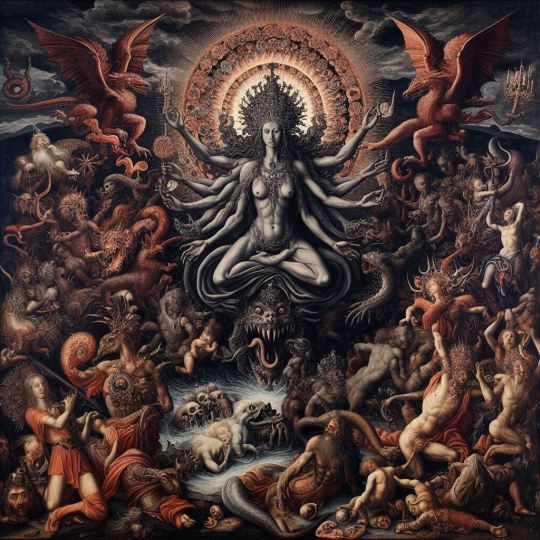
When I say I do not use "new age" jargon in my readings it is because I do not believe we are living in a "new age" and certainly not in a period of enlightenment, in fact we are living in a very old age and a very dark one. Not only do I believe most of what is propagated under the Aegis of "new age" is delusional, it is part of the putrefaction itself.
------------------------------------
Situation in Kali-yuga According to the Vedic scriptures, our current age, known as Kali-yuga, is one of spiritual darkness, violence and hypocrisy. Srimad-Bhagavatam (12.2.31) records Kali-yuga as having begun when the constellation of the seven sages (saptarsi) passed through the lunar mansion of Magha. Hindu astrologers have calculated this to have been 2:27 a.m. on February 18, 3102 BC. This took place some 36 years after Lord Krsna spoke Bhagavad-gita to Arjuna.
The scriptures like SB 12.2 teach that during the 432,000 year age of Kali, humanity deteriorates and falls into barbarism. Humans begin to kill animals for food. They fall under the spell of intoxication. They lose all sexual restraint. Families break up. Women and children are abused and abandoned.
Increasingly degraded generations, conceived accidentally in lust and growing up wild, swarm all over the world. Political leadership falls into the hands of unprincipled rogues, criminals and terrorists, who use their power to exploit the people. Entire populations are enslaved and put to death. The world teems with fanatics, extremists and spiritual artists, who win huge followings among a people completely dazed by hedonism, as well as by cultural and moral relativism. “Religion, truthfulness, cleanliness, tolerance, mercy, physical strength and memory diminish with each passing day.” (Srimad-Bhagavatam 12.2.1)
The saints and sages of ancient India describe the people of this age as greedy, ill-behaved, and merciless. In this age, says Srimad-Bhagavatam, merely possessing wealth is considered a sign of good birth, proper behavior, and fine qualities. Law and justice are determined by one’s prestige and power. Marriage ceases to exist as a holy union - men and women simply live together on the basis of bodily attraction and verbal agreement, and only for sexual pleasure.
Women wander from one man to another. Men no longer look after their parents in their old age, and fail to provide for their own children. One’s beauty is thought to depend on one’s hairstyle. Filling the belly is said to be the only purpose in life. Cows are killed once their milk production drops. Atheism flourishes. Religious observances are performed solely for the sake of reputation.
The Linga Purana (ch. 40) describes the human race in Kali-yuga as a vain and stupid people “spurred on by the lowest instincts.” They prefer false ideas and do not hesitate to persecute sages. They are tormented by bodily desires.
Severe droughts and plagues are everywhere. Slovenliness, illness, hunger and fear spread. Nations are continually at war with one another. The number of princes and farmers decline. Heroes are assassinated. The working classes want to claim regal power and enjoy royal wealth.
Kings become thieves. They take to seizing property, rather than protecting the citizenry. The new leaders emerge from the laborer class and begin to persecute religious people, saints, teachers, intellectuals, and philosophers.
Civilization lacks any kind of divine guidance. The sacred books are no longer revered. False doctrines and misleading religions spread across the globe. Children are killed in the wombs of their mothers. Women who have relations with several men are numerous. Predatory animals are more violent. The number of cows diminishes.
The Linga Purana says that in Kali-yuga, young women freely abandon their virginity. Women, children, and cows - always protected in an enlightened society - are abused and killed during the iron age. Thieves are numerous and rapes are frequent. There are many beggars, and widespread unemployment. Merchants operate corrupt businesses. Diseases, rates, and foul substances plague the populace. Water is lacking, fruits are scarce. Everyone uses vulgar language.
The men of Kali-yuga seek only money. Only the richest have power. People without money are their slaves. The leaders of the state no longer protect the people, but plunder the citizenry through excessive taxation. Farmers abandon living close to nature. They become unskilled laborers in congested cities. Many dress in rags, or are unemployed, and sleep on the streets. Through the fault of the government, infant mortality rates are high. False gods are worshiped in false ashrams, in which pilgrimages, penances, charities and austerities are all concocted.
People in this age eat their food without washing beforehand. Monks break their vows of celibacy. Cows are kept alive only for their milk. Water is scarce. Many people watch the skies, praying for rain. No rain comes. The fields become barren. Suffering from famine and poverty, many attempt to migrate to countries where food is more readily available. People are without joy and pleasure. Many commit suicide. Men of small intelligence are influenced by atheistic doctrines. Family, clan and caste are all meaningless. Men are without virtues, purity or decency. (Visnu Purana 6.1).
Now the sinful Kali Age is upon them, when Dharma is destroyed, an Age full of evil customs and deceit. Men pursue evil ways. The Vedas have lost their power, the Smritis are forgotten, and many of the Puranas, which contain stories of the past, and show the many ways (which lead to liberation), will, O Lord! be destroyed. Men will become averse from religious rites, without restraint, maddened with pride, ever given over to sinful acts, lustful, gluttonous, cruel, heartless, harsh of speech, deceitful, short-lived, poverty-stricken, harassed by sickness and sorrow, ugly, feeble, low, stupid, mean, and addicted to mean habits, companions of the base, thievish, calumnious, malicious, quarrelsome, depraved, cowards, and ever-ailing, devoid of all sense of shame and sin and of fear to seduce the wives of others. Vipras will live like the Shudras, and whilst neglecting their own Sandhya will yet officiate at the sacrifices of the low. They will be greedy, given over to wicked and sinful acts, liars, insolent, ignorant, deceitful, mere hangers-on of others, the sellers of their daughters, degraded, averse to all tapas and vrata. They will be heretics, impostors, and think themselves wise. They will be without faith or devotion, and will do japa and puja with no other end than to dupe the people. They will eat unclean food and follow evil customs, they will serve and eat the food of the Shudras and lust after low women, and will be wicked and ready to barter for money even their own wives to the low. In short, the only sign that they are Brahmanas will be the thread they wear. Observing no rule in eating or drinking or in other matters, scoffing at the Dharma Scriptures, no thought of pious speech ever so much as entering their minds, they will be but bent upon the injury of the good. (Mahanirvana tantra 1.37-50)
But since the men of the Kali Age are full of greed, lust, gluttony, they will on that account neglect sadhana and will fall into sin, and having drunk much wine for the sake of the pleasure of the senses, will become mad with intoxication, and bereft of all notion of right and wrong (61). Some will violate the wives of others, others will become rogues, and some, in the indiscriminating rage of lust, will go (whoever she be) with any woman (62). Over eating and drinking will disease many and deprive them of strength and sense. Disordered by madness, they will meet death, falling into lakes, pits, or in impenetrable forests, or from hills or house-tops (63-64). While some will be as mute as corpses, others will be for ever on the chatter, and yet others will quarrel with their kinsmen and elders. They will be evil-doers, cruel, and the destroyers of Dharma (65-66). I fear, O Lord! that even that which Thou hast ordained for the good of men will through them turn out for evil (67). O Lord of the World! who will practise Yoga or Nyasa, who will sing the hymns and draw the Yantra and make Purashcharana? (68). Under the influences of the Kali Age man will of his nature become indeed wicked and bound to all manner of sin (69). (M.t. 1.61-69)
O Vararohe! know that when Vedic and Puranic initiations cease then the Kali Age has become strong (47). O Shive! 0 Peaceful One! when virtue and vice are no longer judged by the Vedic rules, then know that the Kali Age has become strong (48). O Sovereign Mistress of Kaula doctrine! when the Heavenly Stream is at some places broken, and at others diverted from its course, then know that the Kali Age has become strong (49). O Wise One! when kings of the Mlechchha race become excessively covetous, then know that the Kali Age has become strong (50). When women become difficult of control, heartless and quarrelsome, and calumniators of their husbands, then know that the Kali Age has become strong (51). When men become subject to women and slaves of lust, oppressors of their friends and Gurus, then know that the Kali Age has become strong (52). When the fertility of the earth has gone and yields a poor harvest, when the clouds yield scanty rain, and trees give meagre fruit, then know that the Kali Age has become strong (53). When brothers, kinsmen, and companions, prompted by the desire for some trifle, will strike one another, then know that the Kali Age has become strong (54). When the open partaking of flesh and liquor will pass without condemnation and punishment, when secret drinking will prevail, then know that the Kali Age has become strong (55). (M.t. 4.47-55)
0 notes
Text
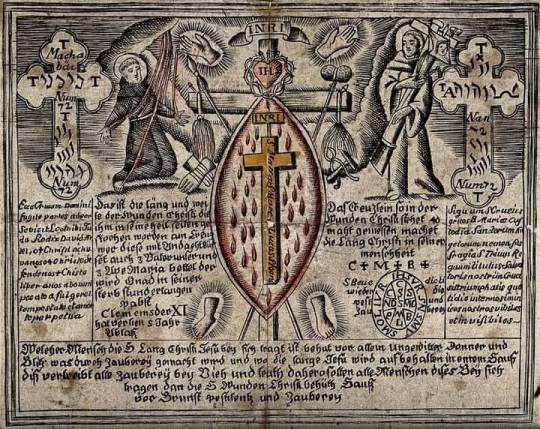
The following passages are from Rene Guenon regarding the degradation of the higher comprehension of tradition into sentimentality. The distinction between metaphysics and religiosity. It is important to note when he uses the term "intellectual" it is not in the contemporary academic sense of the term, but in the sense of noesis or intellection, a higher form of comprehension. This is the level of pure traditional metaphysics. Almost every manifestation of traditional and non-traditional religion in our contemporary society has degenerated into pure sentimentality and used as little more than an Implement of public manipulation.
((Nous (British: pron.: /ˈnaʊs/;US: /ˈnuːs/), sometimes equated to intellect or intelligence, is a philosophical term for the faculty of the human mind which is described in classical philosophy as necessary for understanding what is true or real, similar in meaning to intuition. It is also often described as a form of perception which works within the mind (“the mind’s eye”), rather than only through the physical senses. The three commonly used philosophical terms are from Greek, νοῦς or νόος, and Latin intellectus and intelligentia respectively.))
From Rene Guenon:
'...we have already pointed out the most essential difference between a metaphysical doctrine and a religious dogma; whereas the metaphysical point of view is purely intellectual, the religious point of view implies as a fundamental characteristic the presence of a sentimental element affecting the doctrine itself, which does not allow of its preserving an attitude of entirely disinterested speculation; this is indeed what occurs in theology, though to a degree that is more or less strongly marked according to the particular branch under consideration.
...
The influence of sentimental elements obviously impairs the intellectual purity of the doctrine, and it is only right to say that it does in fact represent a certain falling away from the standpoint of metaphysical thought; this falling away, in the region where it took place generally and extensively, that is to say in the Western world, was in many ways inevitable and in a sense even necessary if the doctrine was to be adapted to the mentality of the men for whom it was being specially framed, men in whom feeling was stronger than intelligence in virtue of a predominance that has reached its climax in modern times. Nevertheless, it remains true that feeling is but a relative and contingent thing, so that any doctrine that makes an appeal to it and on which it reacts in its turn is bound to be relative and contingent; and this is especially noticeable in regard to the need for 'consolations' with which the religious point of view is closely bound up. Truth, in itself, has no need to be consoling; if anyone finds it so, so much the better for him certainly, though the consolation he feels does not emanate from the doctrine, but purely from himself and from the particular predispositions of his own sentimentality.
It follows that a doctrine that adapts itself to the requirements of sentimental beings and that must therefore itself put on a sentimental dress can henceforth no longer be identified with absolute and total truth; the profound change produced in the form of the doctrine by the introduction of a consolatory principle corresponds to an intellectual falling off on the part of the human collectivity to which its message is addressed. Looked at from another angle, it is this characteristic that gives birth to the inevitable diversity of religious dogmas; hence their incompatibility, for whereas intelligence is one, and truth, in whatever measure it is understood, can be understood in one way only, the same does not apply to feeling, so that religion, in seeking to satisfy the demands of feeling, cannot avoid trying to adapt its form as far as possible to its multiple modes, which vary largely according to race and period. This does not mean, however, that all religious forms, in their doctrinal part, suffer the dissolving action of sentimentalism to an equal degree, with its resultant need for change; a comparison between Cathlicism and Protestantism, for example, is particularly instructive in this connection.'
-- Introduction to the Study of the Hindu Doctrines
0 notes
Text
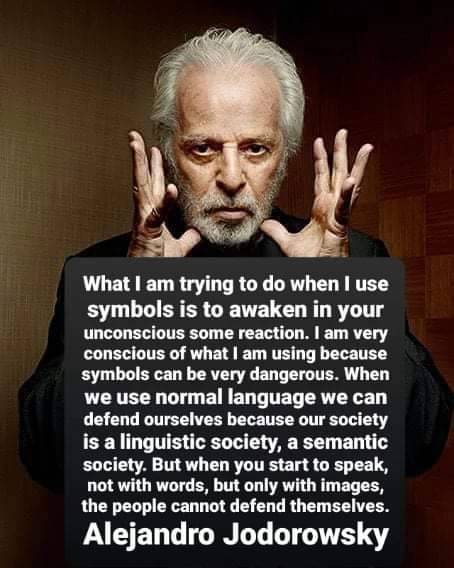
“Magic is not superstition; magic is the nature of the world. The world is not logical or rational, it is magic. Everything is closely related. […] [A]ll events are aligned, united; time is not linear, the effects are sometimes produced before the causes; there are mysteries. Seventy percent of the world cannot understand it, like the chimpanzee does not understand 90 percent of the world. We have a lot to learn. Reality is miraculous, it is magic. It obeys nonscientific principles. Reality is not scientific.” -- Alejandro Jodorowsky
Amusing Amazon review of the moment: Alejandro Jodorowsky's "Manual of Psychomagic" is an incredibly enlightening journey through the mind of a psychopath. The various ritual performances described in this quasi-autobiography convey the author's deeply traumatized psyche, his deep-seated issues with authority figures and women, and his fascination with death and bloodshed. Dark, twisted, and terribly disturbing, this macabre manual leaves readers distraught, wondering just how many of these perverse rituals the author himself has performed and whether they are an indication of even darker acts. This book is an excellent guide for students studying psychology or criminology, brilliantly and painstakingly outlining the mind's descent into madness.
1 note
·
View note
Text

TAROT READINGS
James Sass - Tarot Reader & Advisor
3 card reading $15
7 card reading $35
10 card reading $50
On Instagram, Facebook, or via Text.
In person at Abraxas Books in Daytona Beach Florida.
Here is how the online reading works: After I confirm payment I will get back to you within 24-48 hours with a photograph of the card spread along with the interpretation. Take as much time as you need to chew over it and get back to me with any questions or comments which I will address to the best of my ability. The readings can be done over Facebook messenger, Instagram or by text. You do not have to be online at the same time or respond during the initial reading. I would actually suggest reading the entire interpretation over as a whole before we discuss it and address any questions you may have.
"Access to truth demands a passage beyond the compass of ordered thought. And by the same token: the teaching of transcendent truth cannot be by logic, but only by pregnant paradox and by symbol and image." -- Heinrich Zimmer.
"When you cut into the present the future leaks out." -- William S. Burroughs
If a picture is worth a thousand words, the tarot is a collection of 78 pictures. The tarot is like a 78 page picture book that rewrites itself every time you shuffle the deck into an astronomical number of different sequential combinations and permutations to tell unique story each time.
Every tarot card reader has their own style of communication. I do not use nebulous New Age jargon or cheesy motivational self-help psychobabble. I also do not whitewash anything. I try to describe what I see with as much precision as possible, good or bad.
JDS
_________________________
Over 35 years of Tarot study and experience reading for others. I read exclusively with Tarot of Marseille. One 7-card spread covering past, present, future, forces needed to control, influence of the environment, opposing forces, and outcome, photo interpretation and Q&A = $35. 10 card expanded reading $50. Message me here and/or connect with "James Sass - Tarot Readings" on Facebook or @james.d.sass or @abraxasbooks on instagram. General reading or specific question. Paypal only. Message for details. Feel free to ask any questions in the comments section.
# tarot #tarotcards #tarotspread #tarotdeck. #tarotreading #tarotreader #tarotreadings #tarotreadingsonline #tarotreadersofig #tarotreadersofinstagram #jodorowsky #psychomagic
0 notes
Text
Apocalypse of Asclepius
Darkness will be preferred to light, and death will be thought more profitable than life; no one will raise his eyes to heaven ; the pious will be deemed insane, and the impious wise; the madman will be thought a brave man, and the wicked will be esteemed as good. As to the soul, and the belief that it is immortal by nature, or may hope to attain to immortality, as I have taught you, all this they will mock at, and will even persuade themselves that it is false. No word of reverence or piety, no utterance worthy of heaven and of the gods of heaven, will be heard or believed.
And so the gods will depart from mankind, a grievous thing!, and only evil angels will remain, who will mingle with men, and drive the poor wretches by main force into all manner of reckless crime, into wars, and robberies, and frauds, and all things hostile to the nature of the soul. Then will the earth no longer stand unshaken, and the sea will bear no ships; heaven will not support the stars in their orbits, nor will the stars pursue their constant course in heaven; all voices of the gods will of necessity be silenced and dumb; the fruits of the earth will rot; the soil will turn barren, and the very air will sicken in sullen stagnation. After this manner will old age come upon the world. Religion will be no more; all things will be disordered and awry; all good will disappear.
But when all this has befallen, Asclepius, then the Master and Father, God, the first before all, the maker of that god who first came into being, will look on that which has come to pass, and will stay the disorder by the counterworking of his will, which is the good. He will call back to the right path those who have gone astray; he will cleanse the world from evil, now washing it away with water-floods, now burning it out with fiercest fire, or again expelling it by war and pestilence.
-- Corpus Hermeticum, Asclepius III. (C. 1st century c.e.)
1 note
·
View note
